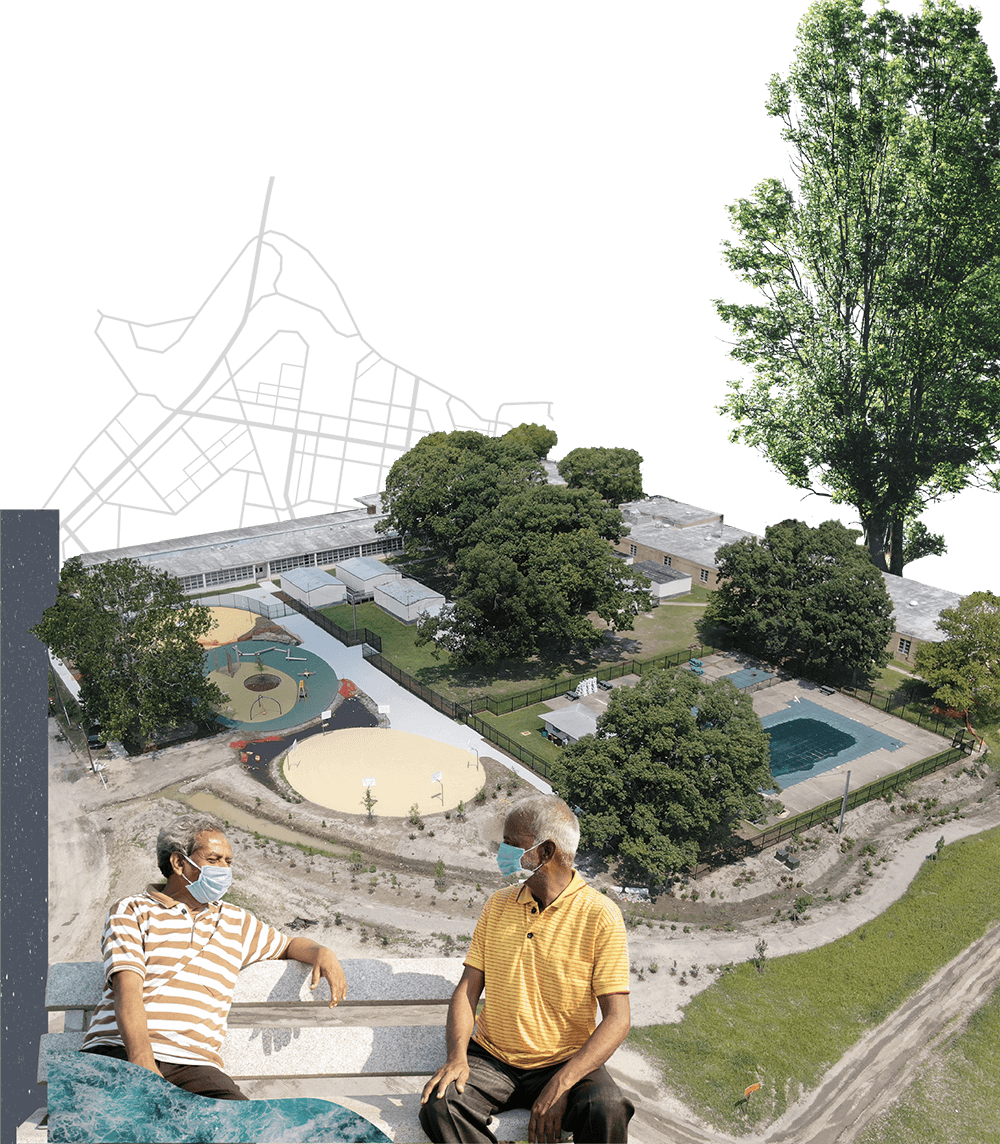A Petri Dish for
Resilience Solutions
As a result of climate change, the US east coast is increasingly at risk of coastal flooding, with the number of high-tide days rising significantly in more than forty coastal communities. 1 By 2050, high-tide flooding in the United States is likely to range between 25–75 days a year, compared to a record twenty days in 2020.2
Norfolk, Virginia, has one of the highest rates of relative sea-level rise in the country. It has gone up by half a foot since 1992, which is twice the global average.3 At the same time, climate change is also causing an increase in the intensity, duration, and frequency of rain events. These compounding events all play a part in increasing Norfolk's vulnerability.
The impacts of floods in Norfolk include:
- property damage to homes and cars;
- disruption of transport infrastructure;
- road flooding, cutting off vulnerable communities from the city;
- disrupted education due to safety concerns for children, which has long-term social and economic consequences; and
- heightened stress and anxiety.
Since 2015, Norfolk's city government has implemented a range of resilience actions through international consultation, private- and public-sector collaboration, and community-led engagement to tackle its flooding crisis. The city aims to be a hub of experimentation and climate innovation. It hopes that by trying a range of new ideas, it can invite city leaders across the United States to see what works in tackling flooding, and inspire others to follow its lead.

Two Resilience Parks, Generations of Change
Before planning the resilience initiatives, Norfolk’s Resilience Office, Planning Department, and Housing and Community Development organized the Dutch Virginia Dialogues. The dialogues brought in experts from the Netherlands to discuss how best to manage coastal flooding—a climate-change impact the Netherlands is familiar with due to its geography.
Following the 2013 dialogues, Norfolk set out a plan to test various resilience solutions to tackle coastal flooding, as part of a wider Norfolk 2100 vision.
These solutions include
- flood walls;
- tide gates;
- pumps;
- community education;
- building and development ordinances;
- rainwater-retention initiatives; and
- “resilience parks,” green spaces with climate- resilient infrastructure.
Ohio Creek Watershed Project
Central to the flood-resilience solutions is the Ohio Creek Watershed, a project funded by a $112-million grant from the National Disaster Competition awarded to the city after Hurricane Sandy. 4
The project integrates a range of interventions, including:
- a resilience park with native plants to absorb stormwater and underground pipes that collect and pump out stormwater;
- two stormwater pump stations to pump rainfall to the Elizabeth River;
- elevating roads to prevent future flooding;
- construction of a berm and rock jetty;
- construction of flood and tidal gates; and
- a living shoreline and wetlands that absorb water and increase biodiversity.

The resilience-park design has been created with community consultation across thirteen different meetings over a period of two years. It includes basketball courts, a children’s play area, and a fishing pier.
The berm is a sea wall that protects the community from coastal flooding. It will be a total of eleven feet tall to meet the worst-case scenario of a hundred-year coastal storm and a simultaneous ten-year rain event. By 2065, when sea levels are expected to rise by 2.5 feet, the berm will still effectively hold back floods and protect the community.
The entire project is borne from collaboration with local universities to design the best flood-resilience strategies, private contractors to build the resilience features, city-government partners to integrate the solutions with housing and parks, and local nongovernmental organizations (NGOs) and the community to ensure the park, in particular, is designed around local people’s needs.

Tidewater Gardens
The Tidewater Gardens public-housing community in the St. Paul’s area of the City is home to 1,600 residents, nine hundred of those residents are children. The neighborhood is built on top of a creek and in low-lying areas, making it vulnerable to floods. The community is being rebuilt, lifting all of the housing out of the floodplain and protecting the community from flooding through a twenty-six acre resilience park which will mitigate flooding, while improving community health and well-being.
The project is funded in part by a $30 million grant from the U.S. Department of Housing and Urban Development and a $14 million grant from the Department of Transportation as part of a $200 million investment to transform the Tidewater Gardens neighborhood.
To start, the city studied and mapped the historic high ground and boundaries of Newton’s Creek and marshes to inform the design of the new buildings, roads and the resilience park. The new design includes daylighting portions of Newton’s Creek in order to hold water and slow down stormwater runoff.

The Department worked with private consultants and a coalition of engineers, landscape architects, the Department of Public Works Stormwater, and the Resilience Office to finalize flood-mitigation measures.
- daylighting the old creek bed, creating a waterway through the park that will hold and store water where it falls;
- construction of retention ponds and bioswales; and
- planting of native trees and shrubs to absorb floodwater.
The department rallied residents around the program through public meetings, leafleting, online surveys, door knocking, a website, and socially distanced meetings, as well as engagement with the tenant-management council.
These conversations helped ensure the park development would match the residents’ needs by including fitness and meditation spaces, a cultural-history trail, and recreational amenities.


Communication and Collaboration
In both Tidewater Gardens and the wider Ohio Creek Watershed project, the city government worked collaboratively with public and private entities to innovate and develop solutions that meet the city’s needs.
Central to all efforts is communication with community members, from involving them in the planning phase through public meetings and surveys to keeping them informed on progress with meetings, postal newsletters, and videos online.

